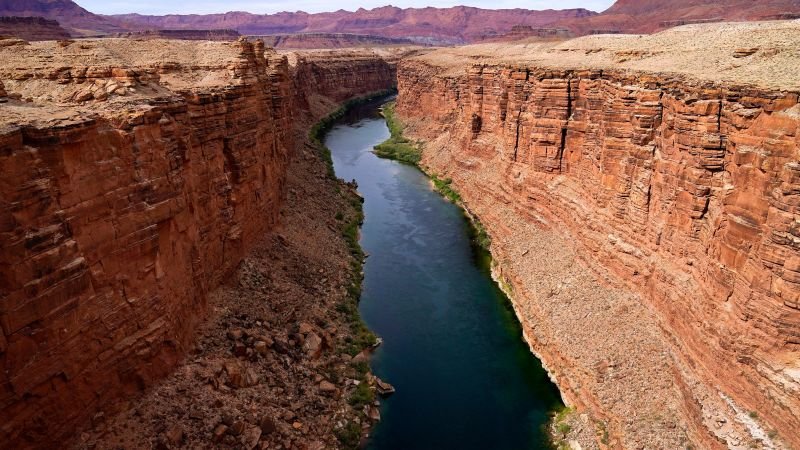CNN —
Rising temperatures have sucked greater than 10 trillion gallons of water out of the Colorado River Basin between 2000 and 2021 – a quantity concerning the dimension of Lake Mead – based on a latest examine.
Researchers at UCLA discovered the human-caused local weather disaster is contributing considerably to the decline of the Colorado River, which runs by means of seven Western states and offers consuming and irrigation water for round 40 million folks. Larger temperatures within the West have resulted in a couple of 10% lower within the river’s circulate within the final twenty years, based on the examine, which was revealed within the American Geophysical Union’s Water Sources Analysis.
The local weather disaster has had such a major influence on the basin that with out it, the river’s first-ever water scarcity wouldn’t have been declared, the researchers discovered. The Tier 1 scarcity took impact in January 2022; a Tier 2 scarcity – resulting from even decrease water ranges at Lake Mead, the nation’s largest reservoir – was carried out in January 2023.
“Once we set out on this examine we have been conscious of the mega-drought and the impacts it was having on Lake Mead’s water ranges,” Benjamin Bass, a water sources engineer and the examine’s lead writer, informed CNN. “We actually needed to supply a examine that was in a position to take a look at that long-term drought occasion and the impacts of anthropogenic local weather change.”
Officers hear throughout a information convention on the Hoover Dam on Lake mead on April 11. John Locher/AP
State leaders and water customers alongside the Colorado River have spent a lot of the final two years scrambling to search out methods to chop their water utilization because the system spiraled to alarming lows.
Final summer time particularly set off alarm bells when the water degree in Lake Mead dropped an astonishing 20 ft over the course of 4 months. Mead, fed by the Colorado River, fell to its lowest degree to-date in July 2022, with lake elevation of 1040 ft. If it falls a further 145 ft, the reservoir hits “lifeless pool,” the purpose at which it’s unable to supply water or hydroelectric energy to tens of millions of shoppers.
The elevated evaporation from rising temperatures is very problematic in snowier states like Colorado, the place the river’s headwaters start.
“It’s rising extra throughout the snow-packed area as in comparison with areas with out snowpack,” Bass stated, noting that reductions of water are taking place “twice as quick” in snowier areas. That’s partly resulting from a optimistic albedo impact – what occurs when extra snow melts with increased temperatures, exposing darker floor that absorbs nonetheless extra warmth.
Bass and a workforce of researchers at UCLA carried out the experiment by modeling stream circulate within the Colorado River basin beneath two situations: one with historic temperature situations and one the place they eliminated the impacts of anthropogenic warming brought on by local weather change. They discovered that local weather change-driven temperatures have had a dramatic influence, lowering flows over time.
Though final winter dumped above-average snowpack and water into the basin, Bass stated that the ten% discount in circulate from 2000 to 2021 has remained constant, even throughout wetter years.
“That’s occurring for moist or dry years,” Bass stated. “Though there’s been a moist winter, there’s nonetheless going to be that 10% discount in runoff.”
The Colorado River flows by means of the Grand Canyon on the Hualapai reservation. John Locher/AP
The UCLA examine got here to an analogous conclusion as one carried out by scientists on the Nationwide Middle for Atmospheric Analysis and the Nationwide Oceanic and Atmospheric Administration, which projected an 11.7% lower in annual stream circulate, factoring in local weather change.
Regardless of utilizing totally different fashions, NCAR hydrometeorologist Ethan Gutmann informed CNN the 2 research got here to the “identical conclusion.”
“We anticipate the longterm will increase in temperature that we all know are going to proceed and for the reason that Colorado River basin particularly appears to be very delicate to temperature, we anticipate runoff on this basin to proceed to say no,” Gutmann stated.
A blockbuster winter has helped Mead’s ranges inch up this summer time. The reservoir is anticipated to achieve a excessive level of 1,070 ft in February 2024, based on the latest federal information. In the meantime, federal officers and state water customers will quickly begin formal negotiations to see how water use within the basin can additional be decreased, an try and counteract many years of overuse mixed with the warmer and drier future within the Western US.
“Except greenhouse gases are curbed, these [water] reductions are going to proceed to trace with temperature will increase,” Bass informed CNN.
